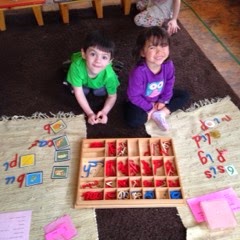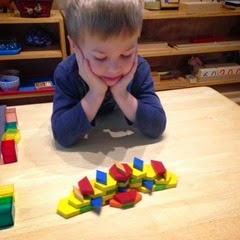"Never help a child at a task at which he feels he can succeed."
Maria Montessori
When Rex was doing this sweeping a little while ago, I asked him if I could show him how to hold the broom a little better. He declined. He was sweeping just fine, thank you. He had already moved all the boots out of the way. As I watched, he swept up a little pile of fir needles and dirt (which collect every day under the boots), he got the dustpan, he gathered up the debris, he dumped it in the trash, and he hung up the broom. Then he headed out to play.
"Helping hands" are a part of every day for us. The children become helpers over time, from the first rolling of rugs when they are just 3, to more complex and meaningful chores when they are 5 or 6. We have our "helping hands" chart which serves as a general guide and encouragement. We change the clips weekly, or more often if the moment is right. It's all a part of our children's house culture. Plenty of negotiations happen in front of this wheel!
A recent article in the Wall Street Journal called "Why Children Need Chores" caught my attention. As I read it, I reflected that I had never written much about how the children help to take care of our children's house, so you can thank WSJ for this blog. The link is below. Near the end of the article, the author wrote this: "... young adults who began chores at ages 3 and 4 were more likely to have good relationships with family and friends, to achieve academic and early career success, and to be self-sufficient, as compared with those who didn't have chores or who started them as teens." Wow! We must remember that in this longitudinal study the chores themselves are not necessarily causative - the chores may reflect a broader, healthier family culture - but it is certainly thought-stimulating.
http://www.wsj.com/articles/why-children-need-chores-1426262655
So what kinds of chores happen here at Chickadee? What are these young children capable of doing? And how does it go for us? I won't pretend that it all goes smoothly, or that every child does something every day, or that they always love helping out. We hear protests, we see quick, sloppy jobs, we navigate objections about how long a child has been doing the same job. But with our flexible consistency, over the months and years that a child is here, the culture of helping to care for their special place is sustained, practiced, and mastered. Here are some glimpses....
 Brady and Henry are washing paint brushes. We've been pairing up younger and older children for some of our jobs this year, and it benefits both of them, mentor and beginner. Washing, rinsing, and rinsing again - for most children, anything with water is a winner!
Brady and Henry are washing paint brushes. We've been pairing up younger and older children for some of our jobs this year, and it benefits both of them, mentor and beginner. Washing, rinsing, and rinsing again - for most children, anything with water is a winner!
Mikaela is rolling up the rugs, leaving their basket more neat and tidy. Every child is given this lesson in her first month with us, because rugs are a work space in constant use. Every child learns how to put away her work rug neatly. But by the end of the morning, rugs are inevitably piled in and flopping over. Straightening them is a simple and satisfying job for a 3-year-old.
Isabel is doing a meaningful job for an older child - she is putting all the snack bowls in the top rack of the dishwasher at the end of the morning. Does your child put dishes in the dishwasher at home? They can do it!
 Sydney is dusting. First she took everything off the shelf and put it on the floor. Then she dusted with this lambswool duster and a yellow cloth duster. Then she put everything back on the shelf. For a more complex or crowded shelf, earlier in the week, Collin has been her partner.
Sydney is dusting. First she took everything off the shelf and put it on the floor. Then she dusted with this lambswool duster and a yellow cloth duster. Then she put everything back on the shelf. For a more complex or crowded shelf, earlier in the week, Collin has been her partner.
Ellie loves to clean the big chalkboard. You can see why - it's so nice and wet and shiny! And since she is one of the children who consistently uses this chalkboard, this job makes perfect sense to her. She's been doing it a lot.
Meanwhile, in the art room Ella is cleaning the easel. Again, because she paints almost every day, this job makes sense to her. We recently covered the easel with clear contact paper, and it's so much easier to wash clean now.
Meanwhile, in the art room Ella is cleaning the easel. Again, because she paints almost every day, this job makes sense to her. We recently covered the easel with clear contact paper, and it's so much easier to wash clean now.
Seamus is mopping the bathroom. Often this a 2-person job, younger and older. First they move the stools to the hall, put water in the mop bucket, take turns mopping, squeeze most of the water out of the mop, and finally dry with an old towel. Every day this happens! The bathroom is small, and the children all know how important it is. (Yes, we still sanitize it.)
For most children, the especially coveted job is lunch helper. Two children come in from outside a little early and do it with Noriko every day, usually for a week at a time. I wanted to get Evangeline into this photo, but she knew that her responsibility was the other room, so she would have nothing to do with a staged photo. Lunch helpers put out the plates and glasses, get the extra chairs from outside, put out the low table for milk, water, and silverware. Finally they put out the name cards, thus choosing where everyone sits (this is power!) Look closely here, and you will see that Noah has his "lunch helper necklace" on.
More helping hands jobs are not shown here - helping make snack, putting it out, and later, cleaning up snack before outside time, folding laundry, sweeping the front porch or back steps, straightening shelves, and so on. You get the idea.
My intent in writing this is not only to say, look at all these jobs these capable children do every day, but to offer gentle encouragement to bring a living culture of helping out into your lives at home. Do follow the link to the WSJ article; it offers some simple guidelines which I don't need to repeat here. An important part of building this shared experience at home is to remember to acknowledge your child by describing what he has done - "the table is clean again," "you matched up all the socks!" Tell him often that he is "becoming a helper" - not just "good job" or "what a big boy." Bring your children into the daily reality of caring and helping at home, and remind yourselves when it gets tricky (which it will, even every day) that over time your children will become more responsible, empathic, self-reliant, and capable people.
More helping hands jobs are not shown here - helping make snack, putting it out, and later, cleaning up snack before outside time, folding laundry, sweeping the front porch or back steps, straightening shelves, and so on. You get the idea.
My intent in writing this is not only to say, look at all these jobs these capable children do every day, but to offer gentle encouragement to bring a living culture of helping out into your lives at home. Do follow the link to the WSJ article; it offers some simple guidelines which I don't need to repeat here. An important part of building this shared experience at home is to remember to acknowledge your child by describing what he has done - "the table is clean again," "you matched up all the socks!" Tell him often that he is "becoming a helper" - not just "good job" or "what a big boy." Bring your children into the daily reality of caring and helping at home, and remind yourselves when it gets tricky (which it will, even every day) that over time your children will become more responsible, empathic, self-reliant, and capable people.


















